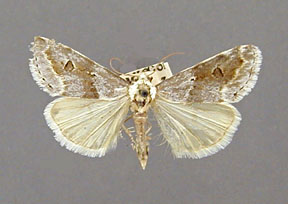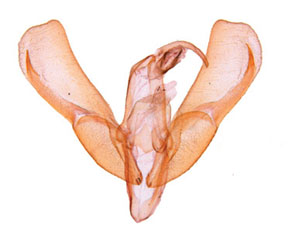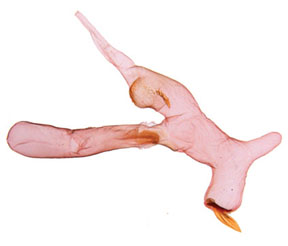



Ponometia megocula |
Ponometia Herrich-Schäffer, 1868
Fruva Grote, 1877
Heliodora Neumoegen, 1891
Graeperia Grote, 1895
Tarachidia Hampson, 1898
Tornacontia Smith, 1900
Conochares Smith, 1905
Neptunia Barnes & McDunnough, 1911
Uniptena Nye, 1975
Ponometia is a large genus of New World Acontiinae with 47 described species. We
list it first because of the bilaterally symmetrical male genitalia. Unlike
Tarache and Acontia, only a few species have a moth that resembles a bird dropping.
The genus is most easily characterized by the relatively small size of the moth (forewing
length: 6–16 mm, but most species 8–12 mm), and the male and female genitalia.
Male genitalia. The valves are bilaterally symmetrical with only a few
species showing slight differences between the valves (e.g., P. albitermen, P. binocula,
P. tortricina). The clasper is a long spine-like process on the ventral margin of the valve
that turns upward, often abruptly so, to project onto the inner surface of the valve.
The diagnostic feature of Ponometia is the vesica; there are one or two long diverticula,
each with a longitudinally-ridged apical cornutus, and there is a comb-like row of small
cornuti on the apical part of the vesica.
Female genitalia . The inner surface of
the corpus bursae is covered posteriorly, sometimes entirely, with large patches of long
spines 5–10 × as long as wide.
Food plants. Food plants are recorded for Ponometia candefacta (Ambrosia spp.),
Ponometia erastrioides (Ambrosia spp.), Ponometia acutus (Ambrosia sp.), Ponometia altera (Haplopappus and Ericameria), and Ponometia libedis (Iva ambrosiaefolia), all in the Asteraceae. In addition Ponometia bicolorata has been reared
from Simsia foetida in the Asteraceae and Heliotropium indicum in
the Boraginaceae.
|


